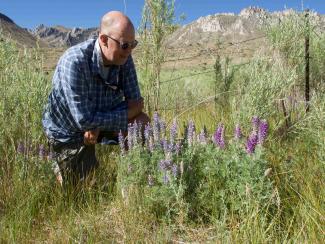
Shirley Tucker Curator of Biodiversity Collections and Botanical Research; UCSB Assistant Researcher
As the Shirley Tucker Curator of Biodiversity Collections and Botanical Research, I manage and curate the UCSB Natural History Collections that are archived at the Cheadle Center. As a plant systematist, and in my role as Assistant Researcher, I am pursing research interests with a focus on floristic inventory in the Western Cordillera of Colombia and taxonomic studies of various groups, including Lupinus in California, Violaceae (Rinorea, Pigea, Hybanthus s.s., Gloeospermum), and several groups in Madagascar: Grewia (Malvaceae), Polygala (Polygalaceae), and Astrotrichilia (Meliaceae). I have the privilege of teaching botany and curation courses in the EEMB and ENVS Departments at UCSB, as well as mentoring and training students in natural history collections curation.
Systematics of Lupines
The genus Lupinus is a highly diverse and taxonomically difficult group. In California, there are about 120 recognized species and varieties, many of which are threatened or endangered. With colleagues in Portugal and Switzerland, I am part of a team seeking to better understand the evolution, historical biogeography, and diversity of lupines. Utilizing both genomic and morphological evidence, we are seeking to infer phylogenetic relationships among the lupines, to understand the radiation of the group in western North America, and to develop a new infrageneric classification for the genus worldwide. My focus is on the taxonomy of several problematic species complexes in California.
Systematics of the Violet Family
The Violaceae is a medium-sized cosmopolitan family composed of 28 genera and ca. 1,200 species of herbs, shrubs, lianas, and trees. While violets and pansies in the genus Viola are familiar plants in the northern hemisphere, the family is primarily composed of woody genera distributed across the tropics. I am part of a team of researchers seeking to understand relationships and generic boundaries within the family, as well as the taxonomic diversity of tree violets (Rinorea), the second largest genus in the family. Forthcoming papers will result in the description of nine new species from the Neotropics and 21 new species from Africa and Madagascar. Collaborators: Harvey Ballard, Jr. (Ohio University), Juliana Paula-Souza (Universidade Federal de Santa Catarina), Saul E. Hoyos-Gomez (Universidad de Antioquia), and Thomas Marcussen (University of Oslo).